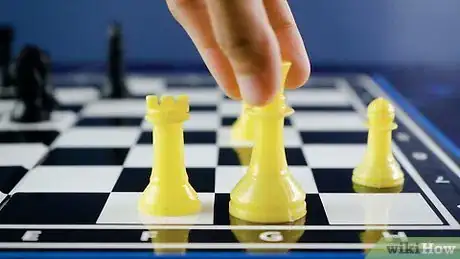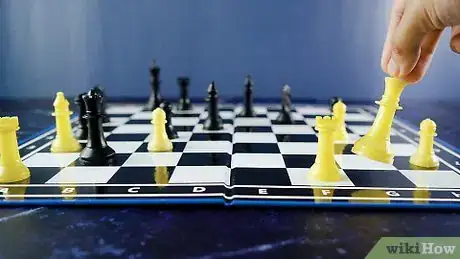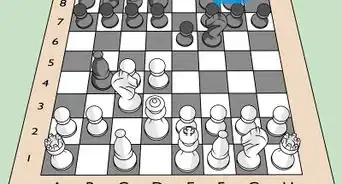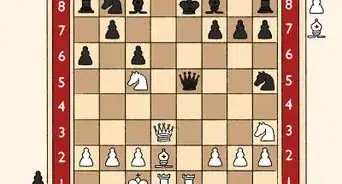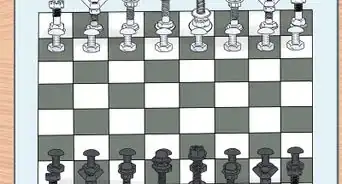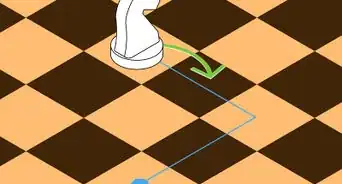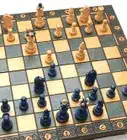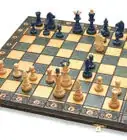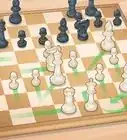This article was co-authored by Vitaly Neimer. Vitaly Neimer is an International Chess Master and Certified Professional Chess Coach with over 15 years of training experience. He has been a part of the United States' Webster SPICE national chess champion team and is also a two-time Israeli national chess champion.
This article has been viewed 218,035 times.
Castling is a special king move in chess in which the king and the rook are allowed to move at the same time. It is the only time two pieces move at once, but the board must satisfy certain criteria for a castling to be appropriate. You can learn to recognize those criteria, execute the move, and use it successfully in a game. See Step 1 for more information.
Steps
Learning the Rules
-
1Make sure the board satisfies the requirements for castling. To castle, you'll need to look at the positioning of your king and the positioning of your rook. Neither piece can have been moved from its original position, even if the pieces have returned to that space, although if you want to castle with one rook, the other can have moved freely.[1]
- All the spaces between the rook and the king need to be free spaces. To castle with the rook to the right of your king, the bishop and the knight on that side need to have moved elsewhere. To castle with the rook to the left of your king, the bishop, knight, and queen must have moved elsewhere. Likewise, these spaces cannot be occupied by your opponent's pieces, meaning you can't castle to capture a piece.
- The king and the rook must not have moved. If your king or your rook has moved before, whether or not it's at the same spot, it cannot castle.
- The king must not currently be in check, move through any squares under attack by enemy pieces, and must not end up in check after castling. If you have been checked previously in the game but has not moved or is not currently in check, you are allowed to castle. If the rook is threatened, you're still permitted to castle.
-
2Move the king 2 spaces towards the rook. The move itself depends on which rook you choose to castle with. You can castle with either of your rooks, to kingside (to the right of the king, a shorter distance) or to queenside (to the left of the king, in which the rook will move one extra space).[2]
- To castle kingside, move your king two spaces right, toward the rook on that side, replacing the original position of the knight, which must be elsewhere.
- To castle queenside, move your king two spaces left, toward the rook on that side, replacing the original position of the bishop on that side, which must be elsewhere.
- Castling is a king move. If you're playing with touch move you'll have to touch the king first or you'll have to make a rook move. Likewise, in online chess you must click on the king, not the rook to castle (if you move the rook the program will assume you meant to just move the rook over).
Advertisement -
3Move the rook to the other side of the king. In the same move, you'll pick up the rook on that side and move it to the space the king moved through to get to its new position. The pieces should be next to one another.[3]
- On a kingside castle, the rook will replace the position of the bishop on that side.
- On a queenside castle, the rook will replace the position of the queen.
Learning When to Castle
-
1Castle only when it works to your advantage. Novice players who've just learned the rule tend to get overexcited and castle needlessly when the board allows for it. While it can be a great way to throw off an encroaching attack or to regroup your pieces for your forward progress, it's not always the smartest play.[4]
- Castling was introduced at some time in the 1500s to increase the speed of play and open up new defensive avenues for players, balancing offensive and defensive strategy into a more fluid style of play.
-
2Castle soon if your king is defended. It's suggested to castle as soon as your King can be protected (and safe from checks) so you can move your rook out. However, be sure to create a "window" if there are pawns above the king and/or have another defending piece.
- This is only a recommendation, and might and will not be for every circumstance. Some find that this helps, some don't. Do not make this something a "have to," and base the choice on your situation.'
-
3Use a castle to free your rook and create offense. The rook can be one of the most difficult pieces to get into play, often not becoming an important offensive weapon until late in a game. If your offense calls for the wide range of the rook, executing a castle can be an excellent way of freeing the rook from behind the pawns.[5]
-
4Wait to castle until your opponent has mounted an offense. The best time for a castling? Right when your opponent has settled on an offensive strategy that depends on your current positioning. If you see your opponent's offense coming together, you might want to hasten to open up room for a castle, then pull the rug out.[6]
- Some players castle early, sometimes within the first five moves, as a way of mounting their offense. If you prefer to orient the pieces having castled, go for it. In general though, you're removing the possibility of a later castle that will throw your opponent off. It's generally used more as a defensive maneuver, rather than an offensive strategy.
-
5Always castle if the center is open. If you've got your king hanging out there with an open centerboard, it's usually good strategy to move him. It's hard to keep track of everything going on in a chess game as it is, meaning that a wide-open board leaves your king vulnerable and you'd be better defended by castling.[7]
- Alternatively, consider leaving your king in place if the action is mostly to the side. An unusual occurrence, perhaps, but it can happen. Play cautiously and read the board always before deciding to castle.
-
6Use your opponent's pieces as a guide. If you're wondering which side, if any, to castle on, let your opponent's pieces give you a clue. Typically, players want to control the middle of the board, but if you're playing against a more idiosyncratic player, they might have overloaded one side with pieces, making you more vulnerable to an attack on that side, making a castle inappropriate. Instead, work the middle of the board to regain control of the most options for an offensive strike.[8]
- Never castle into an attack. Usually your best bet is to castle on the opposite side, taking special care to defend against the pawns as they swarm in. So, if your opponent has overloaded your kingside, castle to the queen.[9]
-
7When in doubt, castle kingside. Many players, beginner and expert alike, agree that castling on the kingside generally better protects your king. It's also usually quicker to castle to the kingside since your queen need not have moved. Keep your pawns structured defensively on the kingside in anticipation of castling.[10]
- Castling kingside is usually a defensive strategy, whereas castling queenside allows for greater offense, with an active queen rook.
-
8Use castling as part of a coordinated offensive strategy. If you want to know more about adding complexity to your chess play and developing more sophisticated techniques, you might want to study
Expert Q&A
-
QuestionWhich side is best to castle in chess?
 Vitaly NeimerVitaly Neimer is an International Chess Master and Certified Professional Chess Coach with over 15 years of training experience. He has been a part of the United States' Webster SPICE national chess champion team and is also a two-time Israeli national chess champion.
Vitaly NeimerVitaly Neimer is an International Chess Master and Certified Professional Chess Coach with over 15 years of training experience. He has been a part of the United States' Webster SPICE national chess champion team and is also a two-time Israeli national chess champion.
International Chess Master Castle on the opposite of your opponent for a game with more attacks, or castle on the same side as your opponent for a more peaceful game.
Castle on the opposite of your opponent for a game with more attacks, or castle on the same side as your opponent for a more peaceful game. -
QuestionHow long can you take to move?
 DonaganTop AnswererIn regular chess, there is no time limit. "Speed chess" is a variant game in which each player has a total allotted time for all of his/her moves and thus would want to move as quickly as possible.
DonaganTop AnswererIn regular chess, there is no time limit. "Speed chess" is a variant game in which each player has a total allotted time for all of his/her moves and thus would want to move as quickly as possible. -
QuestionCan I castle a queen?
 Community AnswerNo, castling always involves the king and a rook.
Community AnswerNo, castling always involves the king and a rook.
Warnings
- In tournament games, castling by moving the rook first and the king next is illegal. If your opponent sees this, you will be forced to move your rook any other way than castling. This is due to the touch-move rule.⧼thumbs_response⧽
References
- ↑ http://www.chessvariants.org/d.chess/castlefaq.html
- ↑ https://www.chess.com/article/view/how-to-castle-in-chess
- ↑ https://www.chess.com/article/view/how-to-castle-in-chess
- ↑ http://www.learnchessrules.com/castling.htm
- ↑ https://www.chessable.com/blog/2019/05/17/how-to-castle-in-chess/
- ↑ http://www.chesscorner.com/tutorial/basic/castling/castle.htm
- ↑ https://www.chessable.com/blog/2019/05/17/how-to-castle-in-chess/
- ↑ https://www.chessable.com/blog/2019/05/17/how-to-castle-in-chess/
- ↑ http://www.chessguru.net/chess_rules/castling/
About This Article
In order to castle in chess, your king and one of your rooks must both be in their original positions, the king must not be in check, and all of the spaces between the king and the rook must be clear. If you are castling kingside, move your king 2 spaces right, and if you are castling queenside, move your king 2 spaces left. In the same turn, move the rook 2 spaces so it’s on the other side of the king, which will complete the castle. If you want to learn when to castle during your game of chess, keep reading the article!

